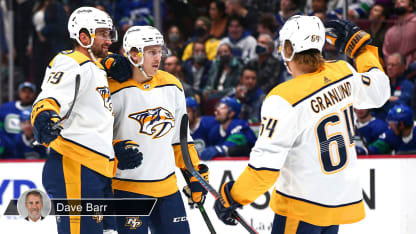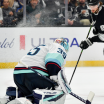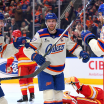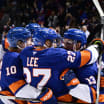2. Nashville Predators (28.9 percent)
The Predators were 23rd last season (17.6 percent), 25th in 2019-20 (17.3 percent) and last in 2018-19 (12.9 percent). Now, they're second.
What has changed?
The power play now relies on interchangeability. Instead of everyone trying to get to their respective spots when they enter the zone, their forwards now set up at the spot nearest to where they are upon entry.
That is huge because it means they aren't missing opportunities or openings that they otherwise might have missed if they were trying to get to set positions on the power play.
A penalty-kill coach scouting the Predators now has a harder time deciphering who will be where on the power play. Nashville is less predictable to opponents because of its interchangeability.
In one instance, the Predators might have a left-shot at the net-front position, but other times it could have a right-shot there. It makes it harder to game plan against.
They're also winning an NHL-best 64.2 percent of their face-offs on the power play. That's up from 51.0 percent last season and 55.2 percent in 2019-20.
A friend who works in analytics told me an improvement of 10 percent on face-offs will help create on average one more scoring chance per power play. If you have three or four power plays per game, that means you're getting another three to four scoring chances per game. The Predators are slightly above that.
Defenseman Roman Josi is shooting more from the middle-top of the zone. In the past, Ryan Ellis was their best shooting threat, but it was more from the left top. The defenseman was traded to the Philadelphia Flyers on July 17.
A long shot from the middle has a better chance of going in or creating a scoring chance because a team is almost guaranteed to have a net-front presence, and a rebound, if there is one, is likely to come out into the middle slot. A shot from the flank could lead to a rebound that bounces out toward the boards, and the net-front presence might cheat in that direction too.


















